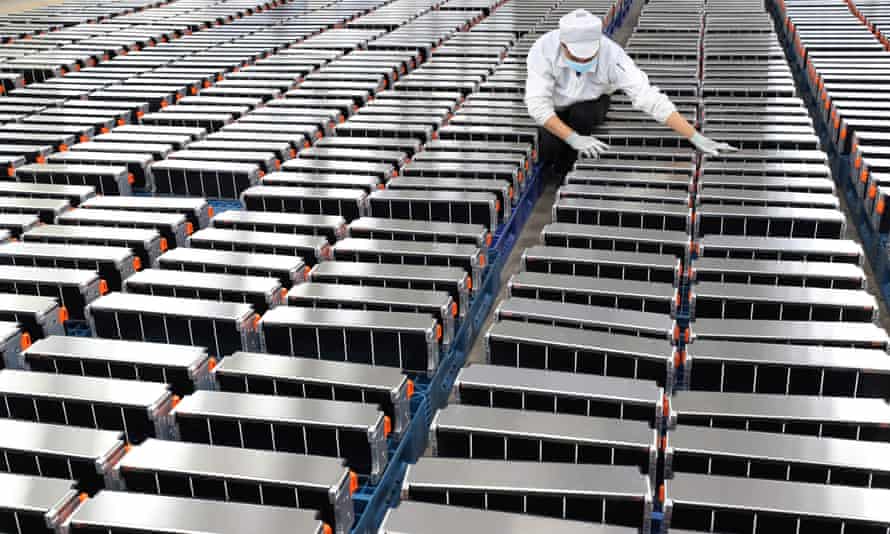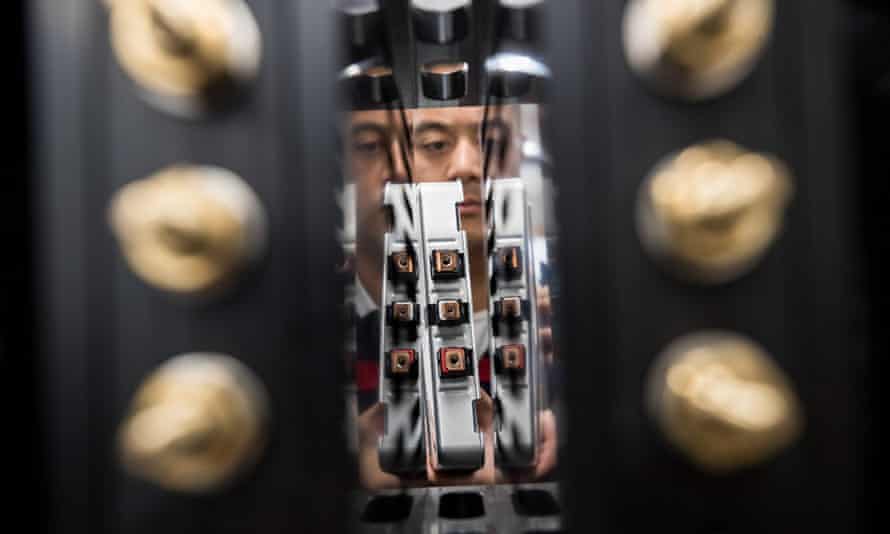Millions of electric car batteries will retire in the next decade. What happens to them?
The quest to prevent batteries – rich in raw materials such as cobalt, lithium and nickel – ending up as a mountain of waste

Last modified on Fri 20 Aug 2021 08.01 EDT
A tsunami of electric vehicles is expected in rich countries, as car companies and governments pledge to ramp up their numbers – there are predicted be 145m on the roads by 2030. But while electric vehicles can play an important role in reducing emissions, they also contain a potential environmental timebomb: their batteries.
By one estimate, more than 12m tons of lithium-ion batteries are expected to retire between now and 2030.
Not only do these batteries require large amounts of raw materials, including lithium, nickel and cobalt – mining for which has climate, environmental and human rights impacts – they also threaten to leave a mountain of electronic waste as they reach the end of their lives.
As the automotive industry starts to transform, experts say now is the time to plan for what happens to batteries at the end of their lives, to reduce reliance on mining and keep materials in circulation.
A second life
Hundreds of millions of dollars are flowing into recycling startups and research centers to figure out how to disassemble dead batteries and extract valuable metals at scale.
But if we want to do more with the materials that we have, recycling shouldn’t be the first solution, said James Pennington, who leads the World Economic Forum’s circular economy program. “The best thing to do at first is to keep things in use for longer,” he said.
“There is a lot of [battery] capacity left at the end of first use in electric vehicles,” said Jessika Richter, who researches environmental policy at Lund University. These batteries may no longer be able run vehicles but they could have second lives storing excess power generated by solar or windfarms.
Several companies are running trials. The energy company Enel Group is using 90 batteries retired from Nissan Leaf cars in an energy storage facility in Melilla, Spain, which is isolated from the Spanish national grid. In the UK, the energy company Powervault partnered with Renault to outfit home energy storage systems with retired batteries.

Establishing the flow of lithium-ion batteries from a first life in electric vehicles to a second life in stationary energy storage would have another bonus: displacing toxic lead-acid batteries.
Only about 60% of lead-acid batteries are used in cars, said Richard Fuller, who leads the non-profit Pure Earth, another 20% are used for storing excess solar power, particularly in African countries.
Lead-acid batteries typically last only about two years in warmer climates, said Fuller, as heat causes them to degrade more quickly, meaning they need to be recycled frequently. However, there are few facilities that can safely do this in Africa.
Instead, these batteries are often cracked open and melted down in back yards. The process exposes the recyclers and their surroundings to lead, a potent neurotoxin that has no known safe level and can damage brain development in children.
Lithium-ion batteries could offer a less toxic and longer-lasting alternative for energy storage, Fuller said.
The race to recycle
“When a battery really is at the end of its use, then it’s time to recycle it,” Pennington said.
There is big momentum behind lithium-ion battery recycling. In its impact report, published in August, Tesla announced that it had started building recycling capabilities at its Gigafactory in Nevada to process waste batteries.
Nearby Redwood Materials, founded by the former Tesla chief technology officer JB Straubel, which operates out of Carson City, Nevada, raised more than $700m in July and plans to expand operations. The factory takes in dead batteries, extracts valuable materials such as copper and cobalt, then sends the refined metals back into the battery supply chain.
Yet, as recycling becomes more mainstream, big technical challenges remain.
One of which is the complex designs that recyclers must navigate to get to the valuable components. Lithium-ion batteries are rarely designed with recyclability in mind, said Carlton Cummins, co-founder of Aceleron, a UK battery manufacturing startup. “This is why the recycler struggles. They want to do the job, but they only get introduced to the product when it reaches their door.”
Cummins and co-founder Amrit Chandan have targeted one design flaw: the way components are connected. Most components are welded together, which is good for electrical connection, but bad for recycling, Cummins said.
Aceleron’s batteries join components with fasteners that compress the metal contacts together. These connections can be decompressed and the fasteners removed, allowing for complete disassembly or for the removal and replacement of individual faulty components.
Easier disassembly could also help mitigate safety hazards. Lithium-ion batteries that are not properly handled could pose fire and explosion risks. “If we pick it down to bits, I guarantee you, it’s not going to hurt anyone,” Cummins said.
Changing the system
Success isn’t guaranteed even if the technical challenges are cracked. History shows how hard it can be to create well-functioning recycling industries.
Lead-acid batteries, for example, enjoy high rates of recycling in part due to legal requirements – as much as 99% of lead in automobile batteries is recycled. But they have a toxic cost when they end up at improper recycling facilities. Spent batteries often end up with backyard recyclers because they can pay more for them than formal recyclers, who have to cover higher operating costs.
Lithium-ion batteries may be less toxic but they will still need to end up at operations that can safely recycle them. “Products tend to flow through the path of least resistance, so you want to make the path which goes through formal channels less resistant,” Pennington said.
Legislation could help. While the US has yet to implement federal policies mandating lithium-ion battery recycling, the EU and China already require battery manufacturers to pay for setting up collection and recycling systems. These funds could help subsidize formal recyclers to make them more competitive, Pennington said.
Last December, the EU also proposed sweeping changes to its battery regulations, most of which target lithium-ion batteries. These include target rates of 70% for battery collection, recovery rates of 95% for cobalt, copper, lead and nickel and 70% for lithium, and mandatory minimum levels of recycled content in new batteries by 2030 – to ensure there are markets for recyclers and buffer them from volatile commodity prices or changing battery chemistries.
“They aren’t in final form yet, but the proposals that are out there are ambitious,” Richter said.
Data could also help. The EU and the Global Battery Alliance (GBA), a public-private collaboration, are both working on versions of a digital “passport” – an electronic record for a battery that would contain information about its whole life cycle.
“We are thinking about a QR code or a [radio frequency identification] detection device,” says Torsten Freund, who leads the GBA’s battery passport initiative. It could report a battery’s health and remaining capacity, helping vehicle manufacturers direct it for reuse or to recycling facilities. Data about materials could help recyclers navigate the myriad chemistries of lithium-ion batteries. And once recycling becomes more widespread, the passport could also indicate the amount of recycled content in new batteries.
As the automobile industry starts to transform, now is the time to tackle these problems, said Maya Ben Dror, urban mobility lead at the World Economic Forum. The money pouring into the sector offers an “opportunity to ensure that these investments are going to be in sustainable new ecosystems and not just in a new type of car”, she said.
It’s also worth noting that sustainable transport goes beyond electric cars, said Richter. Walking, biking or taking public transportation should not be overlooked, she said. “It’s important to remember that we can have a sustainable product situated within an unsustainable system.”
